
Italy Diary - 22 Day Globus Tour - Page 4June 1999by Kathi and Wayne JacobsCopyright 2018 VITA Digital Productions - All Rights Reserved |
Day 10 - Wednesday - June 30, 1999: Venice to Ravenna to Assisi: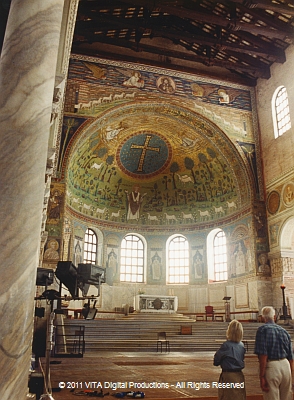
Up and to breakfast in the hotel dining room. Then onto the tour bus and we leave Venice, driving along the coast, through tidal marshes, and next to the Adriatic Sea. In Ravenna we stop for coffee at a little roadside café. After our snacks are finished, we walk across the street and enter the 6th century Basilica of St. Apollinaris in Classe. Vincenzo purchases our tickets and, after a short history of the basilica from him, we enter the sanctuary itself. The church has beautiful gold mosaics on the walls and ceilings. Back on the tour bus, Piero, our driver, makes a wrong turn and has to back out of a dead end street - the only mistake we ever see him make on the tour. Back on the highway, we continue on, crossing the Apennine Mountains and heading toward today's destination, the little hilltop town of Assisi. Stopping at the ubiquitous "Auto Grill," for lunch, we stand in the usual slow-moving lines. The Italians have devised a hellishly complicated system for ordering food in these types of shops: a customer is required to stand first in one long, slow moving line to order and pay for the items one wishes to purchase, then, taking the printed ticket they have received, they walk a short distance only to stand in another long, show moving line. Finally after waiting patiently in the second line, they are waited on, and handing the receipt to the cook who then, and only then, begins to cook or otherwise prepare their order! And when several tour buses arrive at an "Auto Grill" at the same time (and this happens more often than not), you can only imagine the needless waiting and long lines that ensue. Kathi and I find tables on the terrace and eat our lunch overlooking a small stream that will become the mighty Tiber River. |
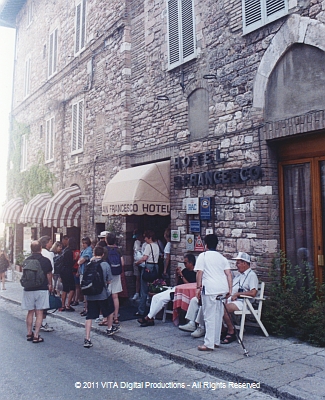
Arriving in Assisi, we leave the bus and our luggage half way up the mountain where we use a covered escalator to get our group to the top of the mountain. Once there, we have to walk for twenty minutes through the city gate and on to the far side of the little town, where we check into our hotel, the San Francesco, a charming 13th century converted monastery. Our bags arrive and after some unpacking, Kathi and I walk the short distance to the Basilica of St. Francis. The Basilica and town were heavily damaged during an earthquake two years ago and rebuilding is still going on. |
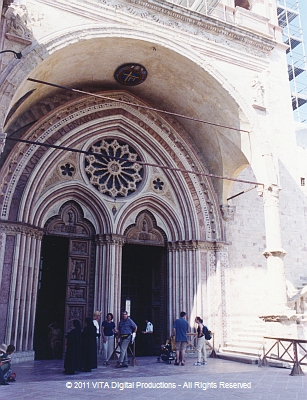
Upon entering the lower Basilica (the upper Basilica is closed for repairs) Kathi and I are touched by the obvious loving care taken in adorning this simple but large church built to honor St. Francis. Hand painted stone supports stretch from the floor to the center of the ceiling and it is clear that many thousands of hours of painstaking care went into their construction. This church is on a more human scale than either St. Peter's in Rome or the Duomo in Florence and therefore, at least for me, has a greater emotional impact. I can actually "feel" the love and devotion which went into its construction and I am moved to tears because of it. Leaving the sanctuary and entering the crypt in the back, we learn through displays and artifacts of St. Francis and the tremendous sacrifices made during his life. Returning to the sanctuary, I see someone taking photos in total disregard of the "No Photography" signs which are posted everywhere, and I glare at them and shake my head, "No." It seems such a sacrilege to be doing anything to despoil the atmosphere of this sacred place. I, of course, take no photographs inside - this is a special place. |
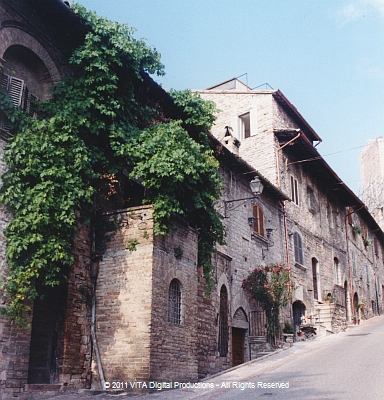
Leaving the Basilica, Kathi and I walk through some of the back streets of Assisi. What a charming town. Everything is built of stone here, all the homes, apartment houses, shops, and even the streets. And the door of each house is unique. I stop frequently to take photographs of the beautiful doors and Kathi patiently waits for me to do this. Approaching the top of a hill, we see a little boy with a large dog. I start videotaping both of them, and about the time I get about 4 feet from the boy, the dog lunges forward stopping about 12 inches from my body and growling viciously. The little boy just barely able to hold on to the dog's leash, I walk quickly out of harm's way. What a close call. Our dinner tonight in the small hotel dining room is memorable. The wait staff is very attentive and helpful, the food is delicious and second and even third helpings are offered to us. As we travel around Italy during our Globus tour, staying in different accomodations and eating in different restaurants, we realize that we are sampling regional dishes and that the only constant is that the food is prepared with fresh ingredients and is always delicious. Around twilight Kathi and I decide to check out the view by taking the small elevator to the top floor; we exit and climb some stairs to the large rooftop patio. A spectacular view stretches out below us. The only building higher than our hotel, and therefore with an even more breathtaking view, is the nearby nunnery and several nuns are, in fact, standing on their balcony enjoying the view. |
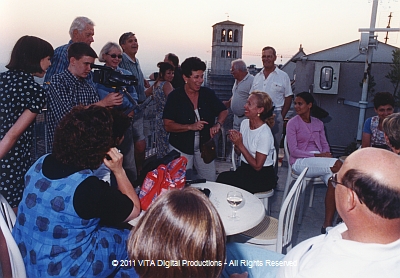
Soon others in our tour group arrive on the patio to enjoy the view. By twilight most of our group are present and I decide to take a group photo. Rushing down to our room, I return with my mini tripod and self timer along with my camera and flash. Setting everything up on a table, I assemble our group and take two photos at sunset with the spire of the basilica in the background. Afterwards, we all sit around the tables talking, relating our travel experiences and having a wonderful time enjoying each other's company. I hand Justin my Steadicam and camcorder and he begins to videotape the conversation. Harold tells a few of his classic "Thibodeaux and Boudreaux" Cajun jokes and we all laugh at his antics while he acts out the roles. |
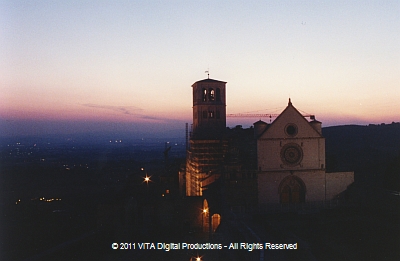
As the sun sets and the sky turns a rosy red, we realize what an exceptional evening this truly is. After the sun goes down, we continue sharing stories and experiences until late into the night. |
Day 11 - Thursday, July 1, 1999 - Assisi to Naples to Pompeii to Sorrento:Breakfast in the hotel dining room and then a short walk down the hill to our tour bus (why did we take the long way up and the short way down the mountain - and not the reverse?) We get an early start today because our next hotel in Sorrento is 300 miles away. Traveling through the outskirts of Naples, Vincenzo asks if we need a bathroom stop before our stop at Pompeii, informing us that Pompeii is still an hour away. We all respond affirmatively and he describes our upcoming strategy: we will stop at a cameo factory which has excellent free restrooms. But in order to utilize the free restrooms, we will have to first watch a short demonstration of how cameos are made and then pretend that we are interested in possibly purchasing some of their stock. Then and only then, may we go downstairs and use the restrooms. "Oh, what a tangled web we weave, when first we practice to deceive." Everyone understands what we are to do and we exit the bus and enter the cameo factory. Actually, the demonstration was quite interesting and their cameos were beautiful: so nice, in fact, that several of our group actually made purchases. And the restrooms were clean and …… better yet, they're free! Later, I begin to suspect that Vincenzo's objective all along was for us to visit the Cameo Factory - he used a "carrot" (the bathroom) in order for us to agree to stop at what otherwise would have appeared to be an obviously unnecessary commercial visit. Restrooms are a problem all over Italy. First and most importantly there's too few of them. Surprisingly, many stores and restaurants do not have public facilities at all. And when they do, you are expected, actually required to purchase something before using them. On several occasions, Kathi and I entered a café or restaurant with the restroom our main goal, only to discover after placing our order, that there were no public facilities. Kathi, who was never fond of fast food restaurants, learned on this trip to appreciate the McDonalds Restaurant chain, primarily because they always had free, clean, American style toilet facilities. Second, their hygiene leaves a lot to be desired - one is apt to find facilities which are everything from untidy to absolutely filthy. And third, you are expected to pay to use them. Five hundred lire is the standard fee expected everywhere. In fact, restrooms appear to be the only reason that 500 lire coins exist. Since sales or V.A.T. tax is already included in the price quoted for goods and because the price quoted is always in multiples of one thousand lire, there appears to me to be no other use for the 500 lire coins. I did learn, however, that it was wise to keep an ample supply of these 500 lire coins available in my pocket at all times. Usually upon entering the restroom, one first passes through an anteroom in which a lady attendant sits with a plate or bowl placed prominently on a counter. Her position as a sort of "gate keeper" requires you to pass directly past her and her "tip" plate before you can approach the next room which contains the small stalls. In most restrooms there are totally separate facilities for men and women but in at least a few places we visited in Italy, there was only one anteroom and one secondary room in which men and women waited side by side to enter the next available stall. It was, not surprisingly, a little disconcerting to Americans. A warning to readers: I am now going to discuss the actual mechanics of Italian toilets. Those readers who prefer may skip these two paragraphs, otherwise, for those remaining brave souls, read on. Italian toilets have some apparent design deficiencies. First, they are smaller and shorter than their American cousins but their biggest fault lies in something known as the "water pan," the quantity of water that is kept by the toilet between flushes. Italian toilets just don't have a "water pan" and they should. They instead rely on a greater force and quantity of flush water to solve the problem - which it usually doesn't. Therefore the ubiquitous toilet brush was beside every toilet I visited - patrons were expected to solve whatever problems the flush had left unfinished. And, human nature being what it is, those problems were usually left behind for the next patron. |
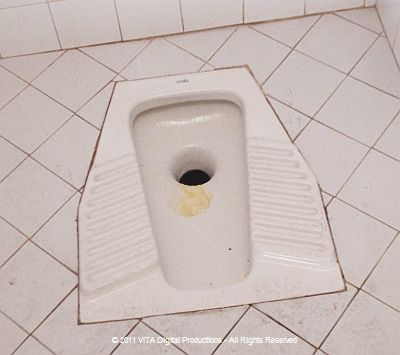
But the most puzzling question regarding water closets in Italy was the unusual flat porcelain floor structure which one encountered in place of traditional commodes from time to time. This structure was constructed of glazed white porcelain and was flush with the floor of the stall. It had molded into its sides, two corrugated foot placements with a gently sloping surface between, leading into a hole, all without any sort of "water pan." Mounted on the wall nearby was the flush valve. At first I assumed this was some sort of male urinal but quickly discovered that women's restrooms had them too, so the mystery continued. Was one supposed to squat when using this appliance? I attempted this once without much success in the restrooms atop St. Peter's Basilica in Rome. Yes, atop St. Peter's in Rome. There are restrooms on the roof of St. Peter's for use by visitors who climb to the top of the dome. In any event, I never mastered their proper usage and continued to wonder why Italians would bother to install them when traditional commodes would have cost about the same price and been much more useful. |
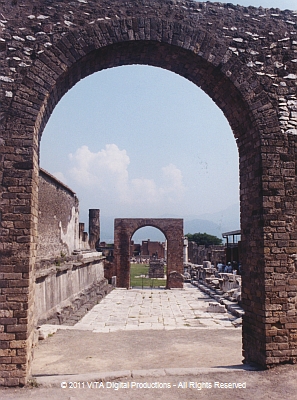
Arriving at Pompeii, our group exits our tour bus and meets our guide. Entering at the Marina Piccolo gate, we pass through an arch and find ourselves inside the ancient city. The stones that pave the streets have grooves worn into them by thousands of chariot wheels. The first thing one notices about Pompeii is the dust - it is everywhere. Volcanic dust preserved the city when Mount Vesuvius erupted on August 24th, 79 AD, and it seems to be attempting to slowly reclaim it. Our group enters the basilica and marvels at its size. I am surprised to learn that most of the marble columns are not marble at all, merely bricks cemented into a columnar shape and then covered in a cement made with marble dust. The ancient Romans were certainly creative, they not only invented cement but they invented imitation marble columns as well. The city has sidewalks with raised stepping stones at street intersections to prevent soiling one's feet in the street (which was utilized as a sewer), but also to control the chariot traffic as well. The raised stones functioned a little like today's "speed bumps" necessitating the chariot drivers slowing down as they entered the intersection in order to maneuver their horses and vehicle accurately between the carefully spaced raised stones. |
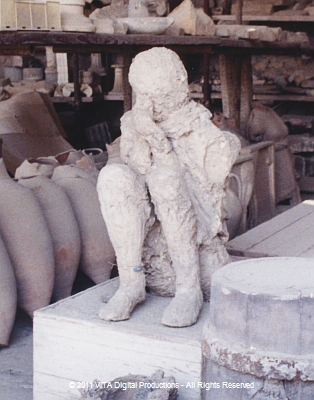
Our guide takes us to the Forum, and there along one side of the ancient gathering area, I see my first "cast." I had, for most of my life, been intrigued by these "casts" which I had seen photographs of in books. They are chilling artifacts of that day in August in 79 AD when Mount Vesuvius blanketed the city in poisonous fumes and ash and killed the few remaining occupants of Pompeii. Discovered early in the excavation of the city, diggers noticed cavities in the hardened ash in which skeletons were located. Someone had the brilliant idea to pour liquid plaster of Paris into the cavity, wait for it to harden and then remove the ash from the resulting cast. Once cleaned, the early archeologists were amazed to see before them a plaster cast in the shape of a human in their death throes, exactly as they had died on that terrible day almost two thousand years before. |
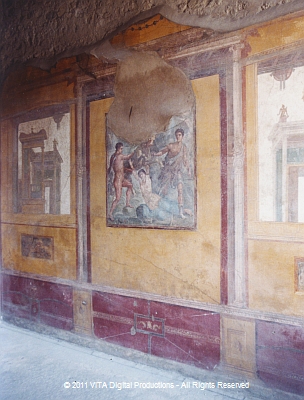
Today, there are many of these plaster casts located throughout Pompeii, some of children and even of dogs. Today's tour of Pompeii lasts only about 2 hours - far too short for me. I'll return later to Pompeii during our five day extension for a much longer examination and photography session. So, after our mini-tour of Pompeii, we return to our tour bus and proceed on to Sorrento. Once at our hotel, the Sorrento Palace, Kathi and I check in, (we are assigned room 89), have time to relax a little, and check out the hotel and grounds and before getting dressed for dinner in the hotel's dining room. And dinner is quite extraordinary - four courses beautifully served - and delicious. After dinner, most of our group gathers on the hotel's large marble terrace which overlooks the Bay of Naples. The view is breathtaking, the night magical, and Kathi and I talk and joke with our friends until late into the night. |